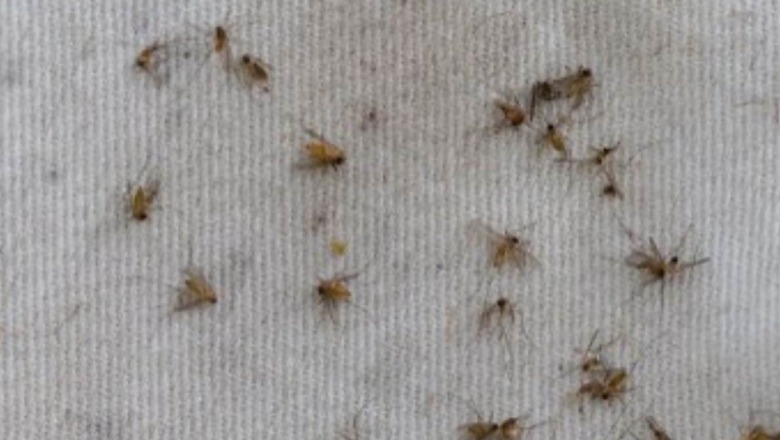
views
Kerala is on alert after a 47-year-old man died on Sunday due to West Nile fever in Thrissur district. Health officials said this was the state’s first death caused by the mosquito-borne disease in three years.
The state health department said it took a proactive decision and issued directions to eliminate mosquito breeding sites as a preventive measure.
Here is all you need to know about the fever caused by the West Nile Virus (WNV):
What is the West Nile Virus?
West Nile virus is an enveloped, single-stranded RNA virus and member of the Flaviviridae family. The Kerala health department said West Nile fever is spread by the Culex species of mosquitoes. According to the World Health Organization, it can cause a fatal neurological disease in humans but most infected will not show any symptoms. It is mainly transmitted through the bites of infected mosquitoes.
The Centers for Disease Control (CDC) states that WNV is the leading cause of mosquito-borne disease in the continental United States. The WHO says birds are natural hosts of WNV, while the virus is maintained in a cycle involving transmission between birds and mosquitoes. Humans, horses and other mammals can be infected.
While the most common cause of infection in humans is due to the bite of an infected mosquito, these vectors are likely to carry the disease if they feed on infected birds. The WHO says WNV can also be transmitted on contact with other infected animals, their blood, or other tissues.
There is a possibility of transmission in humans through organ transplant, blood transfusion and feeding of breast milk. There is one reported case of transplacental (mother-to-child) WNV transmission, the WHO says. But, human-to-human transmission through direct contact has not yet been documented. There are no documented reports among health workers treating infected patients, when they follow standard protocol for infectious diseases. But, there are reports of WNV transmission in lab workers.
What are the symptoms?
According to reports, the man in Kerala developed fever and other symptoms on May 17 and after getting treatment from various hospitals, he was admitted to the government medical college in Thrissur, where he was diagnosed with West Nile fever.
But, approximately 80 per cent of people who are infected will not show any symptoms and those with WNV do not feel sick. According to the WHO, symptoms include fever, headache, tiredness, and body aches, nausea, vomiting, an occasional skin rash (on the trunk of the body) and swollen lymph glands.
Symptoms in case of a more severe disease include headache, high fever, neck stiffness, stupor, disorientation, coma, tremors, convulsions, muscle weakness, and paralysis. The incubation period is usually 3 to 14 days.
But, according to estimates, only one in 150 people infected with WNV develop a more severe form of disease. While WNV can cause serious illness in people of any age, those aged above 50 and some immunocompromised persons are at the highest risk.
How is WNV diagnosed?
There are many different ways to diagnose WNV such as IgM antibody capture enzyme-linked immunosorbent assay (ELISA), neutralisation assays, viral detection by RT-PCR and virus isolation by cell culture. IgM can be detected in close to all cerebrospinal fluid and serum specimens received from infected patients, as per the WHO.
How was it detected?
The Kerala health department, in its advisory on WNV, stated that the vector-borne disease was first detected in a woman in Uganda in 1937. The WHO says it was then identified in birds in the Nile delta region in 1953. Before 1997, a more virulent strain killed different bird species with signs of encephalitis and paralysis in Israel.
But when it comes to humans, infections have been reported across numerous countries for more than 50 years. The largest outbreaks have happened in Greece, Israel, Romania, Russia and USA on major bird migratory routes, as per WHO. WNV is commonly found in Africa, Europe, the Middle East, North America and West Asia.
What are the preventive measures against WNV?
There are no vaccines to prevent or medications to treat WNV in people. There are various health safeguards that can be taken in the absence of a vaccine. Public health measures and awareness drives can reduce risk and exposure to the virus.
Risk of mosquito transmission can be reduced by eliminating mosquito breeding sites, clearing clogged drains and pools of stagnant water in the surroundings. People must be made aware of the use of mosquito nets and mosquito repellents. Bites can be prevented by wearing light coloured clothing, long-sleeved shirts and trousers, as well as by avoiding outdoor activity at peak hours when mosquitoes tend to be more active.
Mosquito surveillance and control programmes must be mandatory in areas where WNV or any other vector-borne disease is commonly reported.
How is Kerala responding?
Kerala has sought public support to control the vector-borne disease after the death of a man in Thrissur district. State health minister Veena George has asked citizens to keep their surroundings clean, so that mosquitoes are unable to breed. She also asked them to clear clogged drains and stagnant water.
Kerala is on high alert and the health department said it took proactive measures by issuing directions to eliminate all mosquito breeding sites. “A special team from the medical office visited the locality of the victim and the district vector control board took samples from various parts of the district for testing. Steps were taken to destroy the mosquito breeding sites in the locality,” said an official press release. All districts have been asked to remain vigilant and take all precautions, including declaring a dry day if necessary.
Kerala first reported the fever in 2006 in Alappuzha, and then Ernakulam in 2011. In 2019, a six-year-old boy from Malappuram died of the fever.
(With PTI inputs)
Read all the Latest India News here




















Comments
0 comment